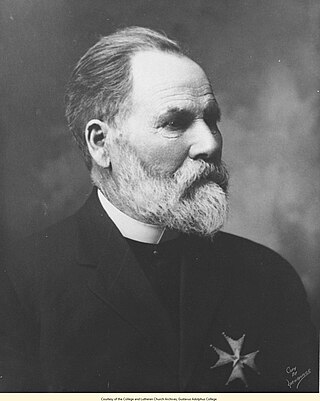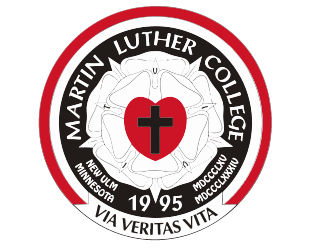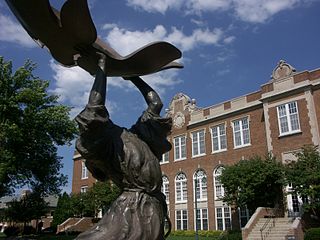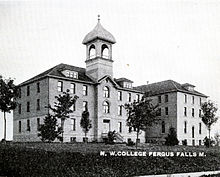
Gustavus Adolphus College is a private liberal arts college in St. Peter, Minnesota. It was founded in 1862 by Swedish Americans led by Eric Norelius and is affiliated with the Evangelical Lutheran Church in America. Gustavus gets its name from Gustavus Adolphus, the King of Sweden from 1611 to 1632. Its residential campus includes a 125-acre arboretum.

Upsala College (UC) was a private college affiliated with the Swedish-American Augustana Synod and located in East Orange in Essex County, New Jersey in the United States. Upsala was founded in 1893 in Brooklyn, New York City, and moved to Kenilworth, and finally to East Orange in 1924. In the 1970s, Upsala considered moving to Wantage Township in rural Sussex County as East Orange's crime problem magnified and social conditions deteriorated. However, the college administration and trustees chose to remain committed to East Orange. Declining enrollment and financial difficulties forced the school to close in 1995.

Eric Norelius was a Swedish-American Lutheran minister, church leader, and author.
The Lutheran Church in America (LCA) was an American and Canadian Lutheran church body that existed from 1962 to 1987. It was headquartered in New York City and its publishing house was Fortress Press.

Martin Luther College (MLC) is a private Lutheran college in New Ulm, Minnesota. It is operated by the Wisconsin Evangelical Lutheran Synod (WELS). Martin Luther College was established in 1995, when Northwestern College (NWC) of Watertown, Wisconsin, combined with Dr. Martin Luther College (DMLC) of New Ulm on the latter's campus.

Hillcrest Lutheran Academy is a private Christian school in Fergus Falls, Minnesota. Established in 1916, Hillcrest is affiliated with the Church of the Lutheran Brethren of America.

Paul T. Granlund was an American sculptor. His creative career spanned more than 50 years and more than 650 different works. Most of his work is figurative and made from bronze. His patrons included colleges, hospitals, Lutheran churches, and other institutions.
The Augustana Evangelical Lutheran Church was a Lutheran church body in the United States that was one of the churches that merged into the Lutheran Church in America (LCA) in 1962. It had its roots among the Swedish immigrants in the 19th century.
The Lutheran School of Theology at Chicago (LSTC) is a seminary of the Evangelical Lutheran Church in America in Chicago, Illinois. LSTC is a member of the Association of Chicago Theological Schools (ACTS), a consortium of eleven area seminaries and theological schools. It shares the JKM Library and portions of its campus with McCormick Theological Seminary. LSTC is accredited by the Association of Theological Schools and regionally accredited by the Higher Learning Commission.

Michigan Lutheran Seminary (MLS) is a coeducational, private preparatory school for boarding and day students in grades 9 through 12. Located in Saginaw, Michigan, the school encourages students to become pastors and teachers in the Wisconsin Evangelical Lutheran Synod, continuing their education at Martin Luther College in New Ulm, Minnesota.
Herbert W. Chilstrom was an American religious leader, who served as the first Presiding Bishop of the Evangelical Lutheran Church in America (ELCA). He was re-elected to a four-year term at the 1991 ELCA Churchwide Assembly in Orlando, Florida. He served as bishop of the Minnesota Synod of the Lutheran Church in America, one of the three church bodies which merged to form the ELCA on Jan. 1, 1988.

The Norwegian Lutheran Church in the United States is a general term to describe the Lutheran church tradition developed within the United States by immigrants from Norway.
Lutheran Brethren Seminary (LBS) is an institute of theological higher education of the Church of the Lutheran Brethren of America (CLBA), located in Fergus Falls, Minnesota. It shares its campus with the denominational headquarters of the CLBA and the denomination’s high school, Hillcrest Lutheran Academy. The seminary’s primary mission is to train and equip pastors, missionaries, and Christian lay workers for ministry in the Church of the Lutheran Brethren and other church bodies.
Illinois State University was a private institution of higher learning in Springfield, Illinois. It began as The Literary and Theological Institute of the Lutheran Church in the Far West in Hillsboro, Illinois, in 1847. It soon became known as the Lutheran College, and, locally, as Hillsboro College. In 1852, it relocated to Springfield and changed its name to Illinois State University. It ceased operations in 1868, but reopened as Carthage College in Carthage, Illinois, in 1870.

Kansas Lake Evangelical Lutheran Church was a small, rural church located near Butterfield, Minnesota, United States. Formed in 1871 by Swedish-Americans settling in the area, the church served the local population for 138 years before closing in 2009.

The Lutheran Minnesota Conference was one of the 13 conferences of the Augustana Evangelical Lutheran Synod. Formed by Swedish immigrants in the 1800s, it originally encompassed Minnesota, parts of North Dakota, South Dakota, Canada, and Wisconsin. Its size was substantially reduced years later when Alexandria, Fargo, and Red River Districts became the Red River Valley Conference in 1912, and the Alberta District and Canada Mission field became the Canada Conference in 1913. With the creation of the Lutheran Church in America (LCA) in 1962, it became known as the Minnesota Synod.
The Red River Valley Conference was formed from a portion of the Lutheran Minnesota Conference of the Augustana Evangelical Lutheran Church in 1912. In 1941, the Red River Valley Conference absorbed the Bismarck and Sheyenne districts of North Dakota, previously of the Minnesota Conference. Originally, the conference included both the Red River Valley as well as North Dakota to the west and extended to the St. Paul District to the east, covering about 300 miles (480 km) west to east and 50 miles (80 km) north to south.
English Evangelical Lutheran Synod of the Northwest was formed in September 1891 as a synod within the General Council of the Evangelical Lutheran Church in North America. Congregations within the synod used English as their primary language to connect with younger generations of English-speakers. The Northwest Synod covered a geographical territory from Milwaukee to Seattle, although few Lutherans lived between Minnesota and Washington. On September 25, 1901 the Northwest Synod split to create the Pacific Synod on the Pacific coast. The Northwest Synod was divided into three conferences: Central Conference, Western Conference, and Wisconsin Conference.
Andrew Jackson was a Swedish-American Lutheran minister who served as president of the Minnesota Conference of the Augustana Evangelical Lutheran Church.
Marcia J. Bunge is an American Lutheran theologian. She is Professor of Religion and the Bernhardson Distinguished Chair of Lutheran Studies at Gustavus Adolphus College in St. Peter, Minnesota.












